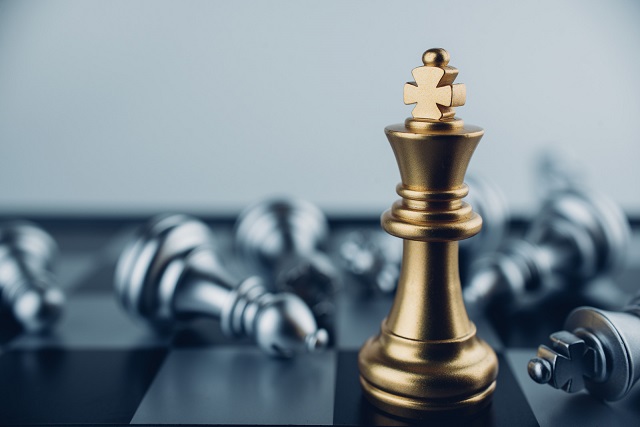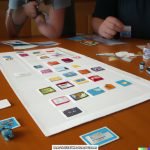
Tactical board games are a type of strategy game that take place on a pre-marked surface. These games often utilize a variety of pieces, dice and other objects to move about the playing area. Often they involve mental mapping and active decision making on how to use the components available to defeat one’s opponent.
For example, chess is one of the classic examples of a tactical board game. Players must plan ahead and block their opponents moves in order to win the game.
Tactical board games generally employ an environment of fairness and equal resources at each player’s disposal. Player abilities are often limited by some form of rules in terms of what items and pieces can be used in certain areas or conditions during the course of play. This creates an interesting balance between utilizing everything within reach but also requires players to think critically on how best to conquer their opponent given the resources at their disposal.
At its heart, what makes tactical board games unique is the focus on planning ahead, often with finite resources, while also understanding entropic processes which may occur with changes over time or because of your opponent’s actions as well as your own.
It puts much weight into initiative steps leading up towards victory or defeat for either party involved while creating an adrenaline rush as each turn progresses along without us knowing where it will go despite all our efforts put forth onto it beforehand.
It tests our ability not just in strategies but our adaptability when it comes to making sure those plans remain effective no matter how unfocused they become over time due to random elements entering in randomly and unexpectedly throughout play.
Tactical Board Games call for strategy far more than luck – although significantly more luck can be present depending on the game or set being played. Each entity added into a tactical board game creates levels upon levels complexity – from basic tactics like setting traps or controlling space, all the way up to hidden information using cards that can open up new possibilities entirely for players simply drawing said card during their set turn in sequence.
All these components together create constantly changing flow within a single game and offer ways even novice players can compete against experienced ones quite easily – if all rules are followed accordingly nonetheless.
A Brief History of Tactical Board Games
Tactical board games have been around for a very long time, with some of the oldest examples dating back as far as 2500 BC. These ancient games were typically designed to teach players strategy and decision-making skills in the form of an entertainment or leisure activity. One of the most popular tactical board games from antiquity was has tâb, a Persian game thought to have originated sometime between 600 and 900 AD.
This two-player strategy game involved placing pieces on a wooden board divided into four sections or rooms. The aim of the game was to capture all your opponent’s pieces by moving your own pieces from room to room.
Modern Tactical Board Games
In modern times, tactical board games have become even more popular thanks to their ability to provide hours of immersive entertainment. Modern tactical board games often require players to think in multiple dimensions in order to outsmart and outmaneuver their opponents.
Games like chess and draughts are some of the most popular examples of tactical board gaming which require players to strategically position their pieces on a checkerboard-like playing field. Many modern tactical board games also involve complex storylines, allowing players complete freedom when it comes to making decisions within their virtual worlds.
Tactical Board Games for Learning
Beyond providing entertainment, tactical board gaming is also increasingly being used for educational purposes. Schools and universities are using these types of boards games as teaching tools in subjects such as maths, science and history due to their intuitive nature which makes learning engaging and fun for students.
Tactical board gaming can also be used as an effective tool for teaching problem-solving skills as it encourages players to analyze situations logically before coming up with a solution that will ultimately bring victory closer into reach. Finally, such games can help develop communication skills within teams or groups by allowing them time together away from technology which allows people process information better in real life conversations than if they were just talking over instant chat online.
Exploring the Benefits of Playing Tactical Board Games
Tactical board games are becoming increasingly popular as a great way to engage in challenging and stimulating activity among friends or family. Although they provide entertainment, there are also many other beneficial aspects of playing these types of games.
One of the main benefits of playing tactical board games is that it gives players a chance to think strategically. Players must consider what moves will have the greatest impact on their overall strategy. This type of thought process teaches people how to plan ahead, anticipate moves by their opponents, and develop better problem-solving skills.
Players also learn about making quick decisions since tactical board games move quickly. This encourages players to make split-second decisions which can teach valuable lessons about decision-making processes under pressure. Additionally, players gain an understanding about the consequences of their actions as they experience the effects of their choices firsthand. This is an important life skill that can be transferred into other situations and roles outside the game itself.
Moreover, tactical board game provide social benefits, such as increasing communication skills amongst participants. Players must articulate their thoughts and explain strategies to one another which helps build trust between everyone involved in the game. It can also help break down barriers between unfamiliar people; since playing together unknown participants often become more comfortable with each other by learning each other’s strategies during playtime.
Some additional advantages associated with playing tactical board games include:
- Fostering creativity
- Developing critical thinking skills
- Improving memory skills
- Enhancing mental agility
Comparing Different Types of Tactical Board Games
Tactical board games are games which require intentional strategy and planning in order to win. Tactics are usually the focus, allowing players to use their skill, instead of chance or luck, to achieve the best outcome. There are many different types of tactical board games ranging from resources management games, sports-themed tactics, and turn-based tactics. Each type offers its own unique set of strategic challenges that require tactical thinking and problem solving skills in order to be successful.
Resources Management Games
Resources management games involve balancing resources while also trying to stymie your opponents plans. The game is won by being the most efficient with producing goods or generating income from limited resources. Examples of tactical board games involving resources include Settlers of Catan and Carcassonne.
In both these titles, players need to acquire or generate resources while also simultaneously competing against other players for similar items. This type of game requires taxes decision making as one must carefully balance what items they spend their money on versus what they should save for later rounds.
Sports-Themed Tactical Board Games
Sports-themed tactical board games often simulate a particular sport but involve elements such as strategy formulation and decision making which go beyond just replicating the physical play found in most modern sports. Titles like Blood Bowl put a strategic twist on the tried and true fantasy football game by offering elements such as team hiring, player movement restrictions and dice-rolled attack outcomes that can affect the overall game design strategy employed by players throughout each match.
Turn-Based Tactical Board Games
Memoir ’44 is a perfect example of a turn-based tactical board game where two players compete against each other for battlefield control by managing action cards and combat tokens while also maneuvering armies across maps representing historical locations and events form World War 2 battles.
This type of game provides total control in terms of actions, allowing players to make precise movements be it an advance or retreat move triggered at any time during ones turn that could help ensure their victory if all decisions are made wisely enough.
Playing Tips for Tactical Board Game Beginners
The tactical board game is one of the most rewarding and mentally stimulating games available today. Learning to play it successfully can be a challenging proposition if you’re new, but with the right know-how, you can quickly get your feet wet in this exciting genre. Here are some tips for winning at tactical board games:
- Understand the rules and mechanics of the game. The best way to improve your tactical board game skills is to familiarize yourself with the unique rules and mechanics of each individual game. This includes understanding which units move in what manner or how to make the most advantageous trades of resources. It’s also important to know all special actions you can take.
- Create short-term goals. Whenever playing a tactical board game, it’s important to have an overarching strategy that pairs with short-term goals. For instance, perhaps your ultimate goal is capturing an opponent’s base, but first you have objectives like gaining resources or building up armies in certain regions.
- Be creative and experiment with strategies. It’s important that you don’t stick to just one strategy when playing a tactical board game – often times there will be hidden secrets or combos on each map that can change how the landscape looks for both players. Try out new tactics and build up as much knowledge as possible about how specific unit types operate.
Tactics when playing tactical board games involve bluffing your opponent into making bad decisions or misreading your intentions by moving in strange patterns. To best utilize these tactics, try constructing fake bases or pretending like you’re going for a resource you don’t actually need while etching out more subtle plans behind the scenes.
It takes practice and creativity, but mastering these psychological games can give you an edge over opponents who are accustomed to more orthodox styles of play.
Another aspect of tactical board games worth exploring is micromanagement – controlling every action done by each unit on the battlefield while visualizing upcoming moves before they happen. Most professional competitive players employ sophisticated networked strategies where they are using two turns ahead from their current position in order better capture their enemies territory without leaving holes in their defenses.
Additionally, micromanagement allows players to pull off timely strikes such as ambushes with advanced stealth units – even though these require great deliberation beforehand, they can help gain advantages during skirmishes by dealing decisive blows quickly over unsuspecting parties not anticipating such attacks.
Breaking Down the Essential Components of a Tactical Board Game
Tactical board games, often referred to as strategy Games, have gained a lot of popularity over the years. These types of games fall into a category that includes classic tabletop games such as chess, checkers, and Go as well as more modern equivalents like Catan and Ticket to Ride. The ability of these games to captivate players and immerse them in intense strategy makes for some of the most popular gaming experiences on the market.
Mechanics
At the heart of any tactical board game is its mechanics-the set of rules that dictate how everything in the game works. Most tactics involve players making moves or taking actions in order to advance their position or gain an advantage over their opponents.
Depending on how a game is designed, mechanics may be fairly straightforward or incredibly complicated. However, they are always essential in making sure the resolution of each match is determined by skillful play rather than luck or chance.
The Player’s Actions
The actions taken by players throughout the course of a game are also important elements of any given tactical board game. In many cases, different movements will trigger events which cause changes to various pieces on the board – such as moving a piece forward which causes it to come into attack range with another – and these can have significant ramifications for those involved in an ongoing match.
Strategic planning allows players to anticipate their opponent’s move beforehand so they can make more effective counter-moves while emphasizing action selection can reward creative decision-making despite what initially appears to be limited options available during a given turn.
Destructive Interactions
An additional common element found in tactical board games are destructive interactions – essentially when one player directly harms another player’s pieces or resources during a match. These highly strategic elements serve not only to make matches more exciting but also provide opportunities for players who weren’t initially favored to suddenly reclaim victory due to one lucky move that completely alters the course of play.
Destructive interactions take many forms; from literally attacking your opponents pieces with your own, forcing them into bad or unfruitful positions relative to yourself, locking down sections of their control area so they cannot expand further, leveraging movement restricitons caused by specific terrain materials, and much more. These types of devious tactics test your wits against your opponents and makes every victory ever sweeter since each competition carries with it an inherent sense of rivalry.
The Top 10 Popular Tactical Board Games
1. Azul – Azul is a popular boardgame designed by Michael Kiesling. The game has been around since 2017 and has won the prestigious 2018 Spiel des Jahres Game of the Year Award. In Azul, players take on the role of royal decorators as they try to beautify the palace of King Manuel I of Portugal with colorful tiles.
2. Cosmic Encounter – Cosmic Encounter is a classic science fiction tactical board game created by Peter Olotka and Bill Eberle and released in 1977. Players take on the role of alien species who compete to control starships, planets, and sectors in a dynamic interstellar sandbox. This intense game requires tactical thinking, strategic card play, and total misdirection to claim victory.
3. Eldritch Horror – Eldritch Horror is an exploration horror-themed adventure board game based on the writings of acclaimed horror author H.P Lovecraft that was released in 2013 by Fantasy Flight Games. Players must investigate mysterious occurrences all over the world while fending off Ancient Ones Cultists and Monsters from beyond time/space before one or more Ancient Ones arrive to consume all life on Earth.
4. Arkham Horror: The Card Game – Arkham Horror: The Card Game is a cooperative Living Card Game developed by Fantasy Flight Games set within the Arkham Fiction Universe created by H.P Lovecraft in 1926-27 time period involving Investigators trying to stop an Ancient One from arising due to their own ritualistic actions. As players explore new locations, battle monsters, collect items and spells they will need to work together if they hope to prevent destruction.
5. Star Wars: Imperial Assault – Star Wars: Imperial Assault is a tactical board game from Fantasy Flight Games where two or more players assume either the role of Rebel Fighters taking on missions against Imperial Forces or becoming those same forces investigating Rebel activity across multiple scenarios or campaigns linked together for narrative purposes.
6. Mechs vs Minions Mechs vs Minions is an immersive strategy game for two-to-four players created by Riot Games in 2016 set in its League of Legends online gaming universe. Players take control of four minoins tasked building various contraptions powered by magic and steam technology while completing mission objectives against rampaging giant mechs trying to destroy them.
7. Twilight Struggle Twilight Struggle simulates the forty five year struggle between Soviet ICBMs (Inter-Continental Ballistic Missiles) and American Defences during 1970’s Cold War period. Regional battlegrounds create points for either side with stakes being raised by playing nuclear weapons cards both sides has access too adding weighty options into play.
8.Monopoly Deal Monopoly Deal changes up the traditional monopoly setup placing power into player hands via designated card decks dealt out each round as they compete against each other for Global Domination. Buy properties,any houses & hotels alongside oil refineries are just some hazards along your way but watch your pocket cause it pays go.
9. Pandemic Pandemic puts four specially trained medical experts on multiple challenges across global challenges from unladen aircraft traveling between cities infected with quickly contagious diseases while overseeing how resources are allocated across regions stopping diseases before pandemics spread else risk devastating world population.
10. Small World Small World pits fantasy armies led diverse races opposing each other competing over scarce geographical landscape divided into provinces spread over multiple continents opting rules that reward conquering small lands over large initial conquests then stretching boundaries further until one faction remains standing miles above rest.
Summing It Up
Tactical board games are a great way for people to challenge their minds and enhance their critical thinking skills. Not only do these games provide a fun and unique way to test your skills, but they also require strategic strategies that can be used in other areas of life. By focusing on the game’s rules and bringing together different elements, such as mathematics, probability, luck, strategy, and problem-solving, tactical board games provide an opportunity for rigorous mental exercise.
One example of this is chess. Chess has been around for hundreds of years because it requires players to think critically about how opponents may act based on the positions of pieces on the board.
As players become more skilled at chess they develop a greater understanding of when to move pieces and plan out several turns in their head before making one. This kind of practice helps players learn various cognitive thinking styles while understanding how to use them in everyday life.
Strategy war-style board games are another type of game that helps improve critical thinking skills. Games like Risk or Stratego require players to think ahead in order to achieve victory over their opponents by planning moves based upon where they place units as well as what resources need protecting or capturing.
Additionally, these types of war-style games require players analyze battle outcomes statistically since multiple factors play into each engagementmaking it important to understand probabilities for success or failure depending on potential choices that could be made on the battlefield.
Overall, tactical board games offer an excellent way for people to expand upon their existing cognitive abilities and learn ways to problem solve effectively while still having fun with friends and family. With many types of tactical board games available there is something that everyone can enjoy learning from no matter your experience level or age range.




